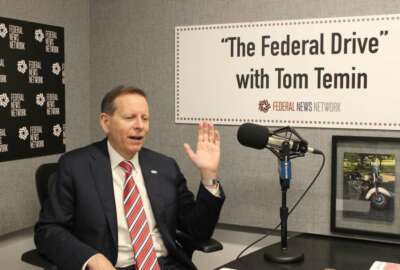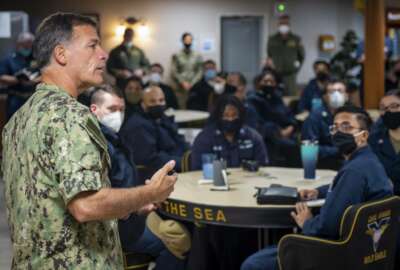The nation’s military working dogs are about to get some overdue recognition
Military working dogs are about to get a sculpture in their honor. Federal Drive with Tom Temin got the story from the president of the War Dogs Association, and...
Best listening experience is on Chrome, Firefox or Safari. Subscribe to Federal Drive’s daily audio interviews on Apple Podcasts or PodcastOne.
Canines have assisted human warfighters in a variety of situations over the years. They even have an association of active duty military members and veterans who make sure the animals get proper treatment when they retire. Now the military working dogs are about to get a sculpture in their honor. Federal Drive with Tom Temin got the story from the president of the War Dogs Association, and former Marine Corps Master Sergeant, Chris Willingham.
Interiew transcript:
Chris Willingham: We’re going to be dedicating, it’s called Service and Sacrifice, it’s a sculpture that pays tribute to sea service canine heroes, past present and future. It features John Douangdara and his dog Bart, they were part of Seal Team Six. And unfortunately, they were killed about 10 years ago when they’re flying, and I should note going towards an operation when it was shot down. And the sculpture itself is absolutely incredible. Susan Bahary did a great job with it. But it also serves as a platform to bring just overall awareness and education to what our military working dogs do for our country. It’ll be dedicated down at the Navy museum down in Washington D.C.
Tom Temin: Got it. Is the sculpture of the dog, and the Seal or just the dog?
Chris Willingham: It’s actually the dog team. So it has the dog and the handler, it has John and Bart. They did a really good job of capturing just that connection the dog and the handler has. So actually has John taken a knee beside his dog and his dog sitting beside him that was taken from a picture. But it really does have captured the bond between the dog and handler. And Susan did a great job with it.
Tom Temin: And Susan being a well known sculptris, correct?
Chris Willingham: Yes, absolutely, her works all over the world. And she’s very well known for especially her work with animals, and particularly military working dogs. She did an incredible job with this, it was no surprise. And I’ve seen pictures, and I’m really looking forward to seeing it in person.
Tom Temin: Got it. And let me just ask you this. You mentioned this is a Service and Sacrifice of Seal Team Six. This is the water services dogs, that is the Navy and Marine Corps animals, correct?
Chris Willingham: Yes, you’re correct. It’s for all sea services, just kind of represents the service and sacrifice of all military working dogs and their handlers.
Tom Temin: And in your experience, and of course you were in the Marine Corps, and they traveled sometimes by sea, but do their work mostly on the ground where you can envision a dog being helpful. What about at sea? Do dogs have duties at sea also?
Chris Willingham: So during Iraq and Afghanistan, obviously the main threat to coalition forces was improvised explosive devices. So with every war in history passes with the use of war dogs, officially since World War II, your job is to basically develop your capabilities to meet the threat you face overseas. So a lot of our efforts were faced towards the counter IED threat in Iraq and Afghanistan. And as those operations started winding down, and combat operations started winding down, we started finding different ways to employ our dogs. The Marine Corps, we started putting dogs with our MEUs, our Marine Expeditionary Units. So they’d either be on a ship or fort staged in a certain country, and they’re able to be pulled, that resource, to wherever they needed to go. So you might go and work in three or four different countries within a seven month deployment. There’s always room for canines. If you’re going to have troops on the ground, if you’re going to have boots in the ground, military working dogs will always have a role because they’re force protection, they’re a force multiplier, and just a fully mission capable asset.
Tom Temin: And besides sniffing out IEDs and explosive devices, which I guess they have really good noses for, what are some of the other tasks that they can perform?
Chris Willingham: So the other part of that is tracking and apprehension. So we have dogs that are trained to track individuals down. It was a very successful program in Vietnam. And then once we started seeing operations pick up in Iraq and Afghanistan, we bought back the combat tracking program. And the idea because we’re having these IEDs laid everywhere, that dogs were able to provide key intelligence on direction of travel for the individuals who lay those IEDs. If you get into a firefight with a small team, once they break contact and go up to where they’re firing position, those dogs can track down and give you a good direction of travel where those individuals were heading. And also like, we’d go out look for high value individuals. So we would go out and target key individuals and those dogs are great for, one, searching up to the breach point, going in helping clear the house for individuals, and then doing a potential tracks for anyone who might have ran out the back door when we’re at the front door. So just absolutely incredible asset on the battlefield.
Tom Temin: We’re speaking with Chris Willingham, he’s a former Marine Corps Master Sergeant and now President of the War Dogs Association. And you had experience with canines in your career. In general is a single canine assigned for its career to a single person or a single platoon, or how does that work?
Chris Willingham: In general terms, the dogs are assigned to the bases. And as long as you’re there, we try to pair up the dog and handler for as long as you’re together just to keep that continuity. But when your time comes up to rotate, the dog will get transitioned to a new handler. I served in the Marine Corps for 20 years, and 17 of those years were in the military working dog program, and just to let you know we do have a couple of our programs where the dogs will stay with the handlers for the lifetime of the dogs. So it kind of depends on where your career sits where you kind of fall into the canine program.
Tom Temin: Sure. And what is the breed of most of the dogs? I think I’ve seen in recent years Belgian Malinois as the main kind of breed. Is that all they use or what are some of the other types?
Chris Willingham: Going back when I first started using dogs, dog fors defense, we had 40-50 breeds. But then over the test of time and looking at trainability, intelligence, they can handle the rigors of combat has come down to really German Shepherds and Belgium Malinois are the top two breeds. Now you have some like Dutch Shepherds, and in the Marine Corps and the army, just for single purpose dogs, we use Labs quite a bit during the height of the wars in Iraq and Afghanistan.
Tom Temin: And you mentioned also that the dog may stay with the handler for the dog’s life, then the association that you had, part of your mission is to make sure the dogs get into good hands when the dogs retire, correct?
Chris Willingham: Yes, sir, that’s correct. So the US War Dogs Association was established in 2005 by Vietnam dog handlers, because unfortunately, the Vietnam dog handlers were not allowed to bring their dogs home from Vietnam, which was a very sad state for our country at that time. We’ve come so far, in the way we treat and care for our military dogs. A lot of us because of the advocacy of Vietnam veteran groups. And Ron Aiello was the president. He helped start the US War Dogs Association in 2000. And I was on the receiving end of care support for my entire career, as well as my Marines. And Ron was a big — he still is a big mentor of mine, and three years ago, asked me to take over, and I absolutely love this organization. So it’s basically a lifecycle of practical support for military working dogs. So when your active duty, we send care packages overseas. When the dog retires, we have a military working dog service award. And then the retirements the big piece. So like when I retired, I had VA benefits, but our dogs don’t get that. There’s no funding available for them right now. So we have fill that need. So right now we’re covering 1,100 retired military working dogs, we pay for their prescription medications every month, which is just absolutely incredible. Because based off the Robbie Law, which was signed into law in 2000, every dog handler has a chance to adopt their dog out. But that also comes with a dog who’s maybe nine years old and starting to have some joint problems. So they’re gladly going to take on that financial burden, because you’re adopting the dog that potentially saved your life, or one of your partners in crime, whatever. But we’re trying to alleviate that financial burden off those handlers, just so they can just focus on just getting that dog the best life possible. So it’s been an incredible experience, get to know more that people were supporting and helps me stay connected to the canine community, but just absolutely loved the mission we have at the US War Dogs Association.
Tom Temin: Sure, having dealt with a couple of old dogs myself, I know how those vet bills can really add up. And just getting back to the early part of the dog’s career. How long does it take to train one to be useful, say, in a given role?
Chris Willingham: Yeah, so you’re looking on average close to about 100 training days. The biggest part is selection, you got to select the right dogs first, so that’s the big part. You’re basically going and looking at a bunch of athletes and you’re trying to figure out which dog is going you’re going to give scholarships to. You got to select the right dogs first. And then once you select them, now you know they have the trainability, they have all the right traits and characteristics. You’re looking at about 100 training days to take a dog from nothing to obedience, explosive detection, as well as the apprehension work and just making sure yourself fully mission capable asset. And at that point, that’s really when the work is beginning because now the dog is met a really solid that basic level of certification. When they get paired up with our handler, they might be another six months before those teams are ready for deployment. They need to learn the ins and outs even though they’re going to grow and develop as a dog team. I mean, at that point, they’re ready for worldwide missions.
Tom Temin: And they have a career of several years then?
Chris Willingham: Yes. So you’re looking at selecting dogs between one year and about two, two and a half years is about the oldest, but usually on average retire at like nine years old, I’d say is that what I’ve seen. I had a dog Lucca, we trained together and she was two years old when I got her, just under two years old, and unfortunately she was injured in Afghanistan, but I had the chance to adopt her at eight years old and she lived another six years in retirement and kept her spoiled and kept her on a couch watching ESPN, and it was great to be able to give that dog the retirement she deserved. I was always hoping my retirements going to be half as good as hers.
Tom Temin: And that’s a really tough loss to when they pass on, isn’t it?
Chris Willingham: It is, it really is, I mean they’re more than just a dog. I think anybody, obviously a lot of pet lovers in the country, but you take that dog and you put yourself in a combat situation, like for example, Lucca was with me through some of the highest of highs you can have in combat, like saving people’s lives by finding IEDs. But also like when I had some bad days and we lost people, Lucca was basically I had my own personal therapy dog, she’s seen me go through some of my worst moments in the Marine Corps and was there for me. So they definitely become more than just a dog. It’s one of your Marines, they become part of your family. Especially in adoption, they change combat patrols for family walks. And it’s incredible just the connection you have. And when Lucca passed away it was it was very difficult, but she had two handlers and both of us were there for her last breath and took her to the beach one more time, got her an ice cream cone. And we’re both sitting there with our hands on her heart just as she took her last breath, but very difficult. It’s nothing easy about it. But it’s just incredible what these dogs do for us both on the battlefield and then personally.
Tom Temin: And do you have a dog at the moment, a retired service dog?
Chris Willingham: I have a yellow lab named Murray. He has a very unique story. Just a quick version, in Iraq, I was working with a guy named Kory Wiens, and he had a yellow Lab named Cooper. And I’ve known him for about a year at that time, and we were on this operation for about a month. And unfortunately, Kory and Cooper were killed during one of our patrols and I kept in touch with the family. And about five years ago, they said they wanted to raise yellow Labs and honor their son. And so the dog comes from a very special family and keeps me a connection to Kory. And we named the dog Murray because on that operation, we were south of Baghdad and the first thing that Kory and I searched was a horse stables and a pool house on the Tigris River. And we turned that into Patrol Base Murray, where did a lot of our missions out of and that’s the last place I saw him. So that dog means a lot. He would never make a working dog, he’s a big goofy lab, but he’s an incredible family pet and means the world to me just having that connection to Kory and his family.
Copyright © 2025 Federal News Network. All rights reserved. This website is not intended for users located within the European Economic Area.
Tom Temin is host of the Federal Drive and has been providing insight on federal technology and management issues for more than 30 years.
Follow @tteminWFED







